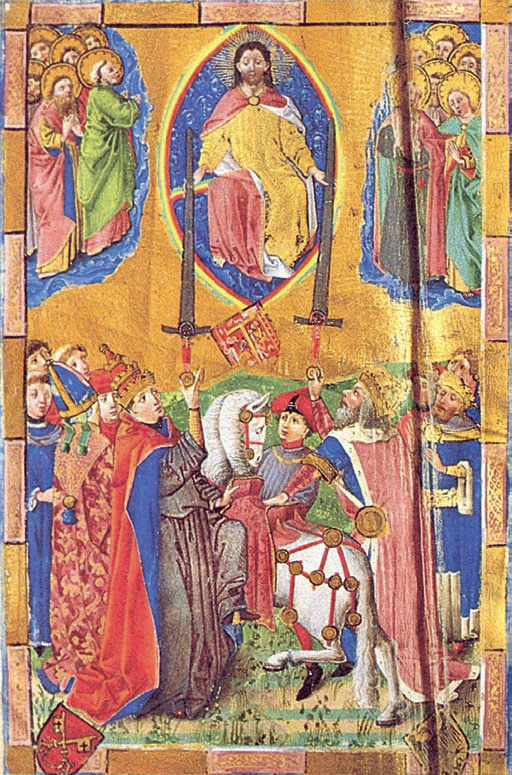doctrine of the two swords on:
[Wikipedia]
[Google]
[Amazon]
 In the Roman Catholicism, the doctrine (or theory) of the two swords is an
In the Roman Catholicism, the doctrine (or theory) of the two swords is an
"Two Swords, Doctrine of the"
in Robert E. Bjork (ed.), ''The Oxford Dictionary of the Middle Ages'' (Oxford University Press, 2010). This particular exegesis of "here are two swords ... it is enough" was first put forward by
 In the Roman Catholicism, the doctrine (or theory) of the two swords is an
In the Roman Catholicism, the doctrine (or theory) of the two swords is an exegesis
Exegesis ( ; from the Greek , from , "to lead out") is a critical explanation or interpretation of a text. The term is traditionally applied to the interpretation of Biblical works. In modern usage, exegesis can involve critical interpretation ...
of ''Luke'' 22:38 elaborated in the Middle Ages
In the history of Europe, the Middle Ages or medieval period lasted approximately from the late 5th to the late 15th centuries, similar to the post-classical period of global history. It began with the fall of the Western Roman Empire ...
. It can be understood as a particular justification for the Gelasian doctrine of "the sacred authority of the priesthood and the royal power".Patrick Stephen Healy"Two Swords, Doctrine of the"
in Robert E. Bjork (ed.), ''The Oxford Dictionary of the Middle Ages'' (Oxford University Press, 2010). This particular exegesis of "here are two swords ... it is enough" was first put forward by
Peter Damian
Peter Damian ( la, Petrus Damianus; it, Pietro or '; – 21 or 22 February 1072 or 1073) was a reforming Benedictine monk and cardinal in the circle of Pope Leo IX. Dante placed him in one of the highest circles of '' Paradiso'' ...
in the 1060s. It was later taken up by Gottschalk of Aachen on behalf of the Emperor Henry IV (1056–1105) against the claims of Pope Gregory VII (1073–1085) during the Investiture Contest
The Investiture Controversy, also called Investiture Contest (German: ''Investiturstreit''; ), was a conflict between the Church and the state in medieval Europe over the ability to choose and install bishops (investiture) and abbots of monast ...
. In the 12th century, Bernard of Clairvaux
Bernard of Clairvaux, O. Cist. ( la, Bernardus Claraevallensis; 109020 August 1153), venerated as Saint Bernard, was an abbot, mystic, co-founder of the Knights Templars, and a major leader in the reformation of the Benedictine Order throug ...
, in his ''De consideratione'', argued that both the "material sword" (''gladius materialis'') and the "spiritual sword" (''gladius spiritualis'') belonged ultimately to the Papacy
The pope ( la, papa, from el, πάππας, translit=pappas, 'father'), also known as supreme pontiff ( or ), Roman pontiff () or sovereign pontiff, is the bishop of Rome (or historically the patriarch of Rome), head of the worldwide Cathol ...
.
By the early 13th century, the two swords were the subject of serious study and debate among canon law
Canon law (from grc, κανών, , a 'straight measuring rod, ruler') is a set of ordinances and regulations made by ecclesiastical authority (church leadership) for the government of a Christian organization or church and its members. It is th ...
yers and decretalists
In the history of canon law, the decretalists of the thirteenth century formed a school of interpretation that emphasised the decretals, those letters issued by the Popes ruling on matters of church discipline (''epistolae decretales''), in prefere ...
. The main question was whether Bernard was right. Had God given each sword to its rightful bearer, the Holy Roman Emperor and the pope, or had he given both to the pope, who then bestowed the material sword on the emperor? When Pope Gregory IX
Pope Gregory IX ( la, Gregorius IX; born Ugolino di Conti; c. 1145 or before 1170 – 22 August 1241) was head of the Catholic Church and ruler of the Papal States from 19 March 1227 until his death in 1241. He is known for issuing the '' Decre ...
started the War of the Keys
The War of the Keys (1228–1230) was the first military conflict between Frederick II, Holy Roman Emperor, and the Papacy. Fighting took place in central and southern Italy. The Papacy made strong gains at first, securing the Papal States and in ...
against Emperor Frederick II in 1228, it was on the basis of a claim to control both swords. In any case, however, churchmen could not bear actual swords; the material swords was to be wielded by laymen, even if under papal authority.Brett Edward Whalen, ''The Two Powers: The Papacy, the Empire, and the Struggle for Sovereignty in the Thirteenth Century'' (University of Pennsylvania Press, 2019), p. 37.
References
External links
* {{Commons category-inline, Doctrine of the Two Swords Catholic political philosophy Political theories Canon law History of the Holy Roman Empire History of the papacy